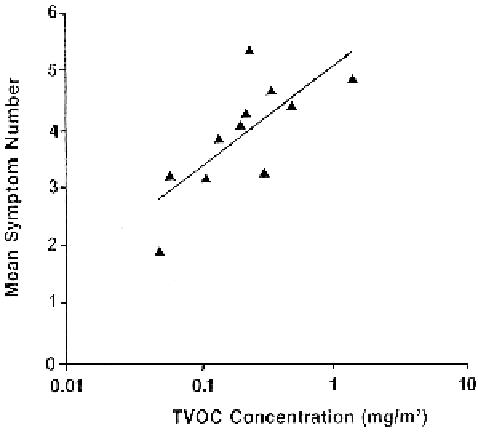Environmental Engineering Reference
In-Depth Information
Figure 4.6
Dose-response relationships between building TVOC concentrations and
symptom prevalence. (From Norback, D., Michel, I, and Winstrom, J.,
Scand. J. Work
Environ. Health
, 16, 121, 1990. With permission.)
log-linear relationships were also observed between symptom prevalence
rates and concentrations of terpenes,
n
-alkanes (C
8
-C
11
), and butanols in
investigations of problem Swedish office buildings. TVOC concentrations
varied from 0.07 to 0.18 mg/m
3
in problem schools and 0.05 to 1.38 mg/m
3
in problem office buildings. In the former case, TVOC levels would have
been at the no-effects level of the Danish model (
Table 4.14
)
.
Elevated SBS-type symptom prevalence in office building investigations
conducted by other Swedish scientists appeared to have been associated
with reduced TVOC levels in office environments. On further data analysis,
a log-linear dose-response relationship was observed between “lost”
TVOCs between intake air and air in office spaces (
Figure 4.7
)
. Symptoms
including fatigue, heavy-headedness, hoarse/dry throat, and dry facial skin
were collinearly related to low level (up to 40 ppbv) increases in room
HCHO concentrations.
An epidemiological study has been recently conducted on a cohort of
170 pregnant women in the United Kingdom in order to evaluate potential
health effects among them and their subsequently newborn children relative
to exposures to VOCs as well as VOC-containing products. The use of air
fresheners was observed to significantly increase the risk of ear infection and
diarrhea in infants and depression and headaches in mothers. Animal studies
indicate that air fresheners may be potent respiratory irritants. Elevated
TVOC levels were associated with both the use of air fresheners and aerosols.
Aerosol use appeared to increase the risk of diarrhea and vomiting in infants
and headaches in mothers.

